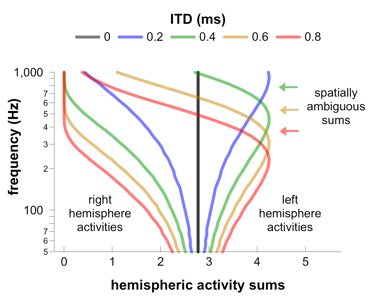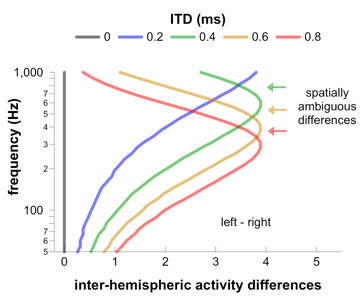The inter-hemispheric channel model of spatial hearing has become popular over the last several decades after having first been proposed by von Békésy in 1930.
As with numerous other acoustic and neural models, the inter-hemispheric model proposes a reasonable representation of interaural time differences (ITD) under ideal listening conditions at low frequencies. The idea is that sounds are spatialized on the left side of the head when activities across midbrain neurons are greater in the right hemisphere than in the left hemisphere. Conversely, sounds are spatialized to the right when left-hemisphere activities exceed right-hemisphere activities. In the example below, five single or recurrent interaural phase differences (IPD) are considered: -0.2, -0.1, 0.0, 0.1, or 0.2 cycles, where IPD is estimated as ITD divided by frequency.
Inter-hemispheric sums and differences for peripheral ITDs become spatially ambiguous as frequency increases, even under ideal listening conditions or when considering binaural signals exemplary of ideal conditions. Importantly, these ambiguities are not due to signal phase wrapping but arise when the medial and lateral slopes of modeled neurons evoke equal activities.


One possible resolution to ambiguities, under the inter-hemispheric model, is if spatial representations are suppressed when overall activities in one hemisphere become low enough. Inter-hemispheric sums or differences might contribute little to spatial hearing, for instance, when ITD is 0.8 ms and frequency exceeds ~300 Hz because negligible activities are evoked in the right hemisphere.
The inter-hemispheric channel model becomes less tenable under typical listening conditions, when spatial cues rarely recur but instead fluctuate over time, or when binaural signals exemplary of typical conditions are considered. The issue is that broad distributions of interaural time differences are expected to evoke inter-hemispherical differences similar to those of single or recurrent values. Yet these signals prompt very different auditory spatial experiences. In the example below, for instance, a hypothetical distribution of five IPDs is considered (0.0, -0.1, 0.1, -0.2, and 0.2 cycles), which culminate in the same inter-hemispheric sums and difference as a single IPD of 0.0 cycles.
A related issue for the inter-hemispheric channel model are inversions of phase or polarity that can occur between the left and right ears under typical listening conditions. Similar to the example above, phase inversions are expected to evoke the same inter-hemispherical differences as single or recurrent interaural differences. Yet, such inversions prompt very different auditory spatial experiences. In the example below, for instance, IPDs of -0.5 and 0.5 cycles are considered, as would occur if IPD was 0.0 cycles but polarity was inverted in either the right or left ear. Inter-hemispheric sums and their difference are nonetheless equivalent to those generated by a single or recurrent IPD of 0.0 cycles.
Similarly to the cross-correlation and maximal models, the inter-hemispheric channel model proposes a reasonable representation of interaural time differences (ITD) at low frequencies under ideal listening conditions. On the other hand, substantial downstream ‘post-processing’ may be necessary to explain spatial hearing under typical listening conditions or when considering binaural signals exemplary of typical conditions. The issue may be further aggravated if ambiguous sums and differences are unencoded and cannot be identified by downstream processes.
Pros:
- • Simple model.
- • Consistent with neurons maximally selective for ITDs corresponding to contralateral directions.
- • Consistent with neurons having steep slopes near the midline.
Cons:
- • Inter-hemispheric sums and differences become spatially ambiguous for peripheral directions as frequency increases.
- • No response patterns exist to identify when sums and differences start to become spatially ambiguous.
- • Sums and differences are ambiguous and inconsistent with spatial hearing when interaural time differences fluctuate.
- • Sums and differences are ambiguous and inconsistent with spatial hearing when signal polarity is inverted in the left or right ear.
- • Requires substantial downstream processing.
Notes:
- • McAlpine, D., Jiang, D., & Palmer, A. (2001) A neural code for low-frequency sound localization in mammals. Nature Neuroscience.
- • Joris PX, Yin TCT. (2007) A matter of time: internal delays in binaural processing. Trends in Neuroscience.
- • Grothe B, Pecka M, McAlpine D. (2010) Mechanisms of sound localization in mammals. Physiological Reviews.
- • von Békésy G. (1930) Zur theorie des hörens. Über das richtungshören bei einer zeitdifferenz oder lautstärkenungleichheit der beiderseitigen schalleinwirkungen (Concerning the theory of hearing; about directional hearing at a time difference or unequal levels of the binaural sound impression). Physikalische Zeitschrift.













